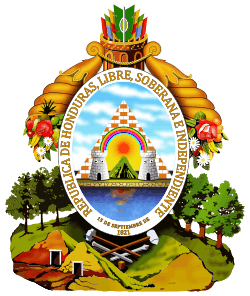Honduran lempira
The lempira (/lɛmˈpɪrə/, sign: L, ISO 4217 code: HNL) is the currency of Honduras. It is subdivided into 100 centavos.
| Honduran lempira | |
|---|---|
| lempira hondureño (Spanish) | |
| ISO 4217 | |
| Code | HNL |
| Denominations | |
| Subunit | |
| 1/100 | centavo |
| Symbol | L |
| Banknotes | L1, L2, L5, L10, L20, L50, L100, L500 |
| Coins | 5, 10, 20, 50 centavos |
| Demographics | |
| User(s) | |
| Issuance | |
| Central bank | Central Bank of Honduras |
| Website | www |
| Valuation | |
| Inflation | 7.7% |
| Source | Central Bank of Honduras, June 2011. |
Etymology
The lempira was named after the 16th-century cacique Lempira, a ruler of the indigenous Lenca people, who is renowned in Honduran folklore for leading the (ultimately unsuccessful) local native resistance against the Spanish conquistador forces. He is a national hero, and is honoured on both the 1 lempira note and the 20 and 50 centavos coins.
History
The lempira was introduced in 1931, replacing the peso at par. In the late 1980s, the exchange rate was two lempiras to the United States dollar (the 20-centavos coin is called a daime as it was worth the same as a U.S. dime). As of March 1, 2019, the lempira was quoted at 24.35 HNL to 1 USD.
Coins
In 1931, coins were introduced in denominations of 5, 20 & 50 centavos, and 1 lempira. One-, 2- and 10-centavos coins were added in 1935, 1939 and 1932, respectively. The silver 1-lempira coins ceased production in 1937, with the other silver coins (20 & 50 centavos) replaced by cupro-nickel in 1967. The 1- and 2-centavos coins were last minted in 1998 and 1974, respectively.
Coins currently in circulation are[1]
- 5 centavos
- 10 centavos
- 20 centavos
- 50 centavos
Banknotes
The Bank of Honduras and the Banco Atlantida issued the first lempira banknotes in 1932. They were in denominations of 1, 2, 5, 10 and 20 lempiras. The Central Bank of Honduras took over production of paper money in 1950, introducing 50 and 100 lempiras notes in 1950, followed by the 500-lempiras note in 1995.
In January, 2010, a new 20-lempira note was introduced to market made by a polymer base, 60 million notes were issued.[2]
Banknotes in circulation are[3]
| Image | New | Value | Color | Dimensions | Obverse | Reverse |
|---|---|---|---|---|---|---|
 |
L1 | Red | 156 × 67 mm | Lempira | Copán | |
 |
L2 | Purple | Marco Aurelio Soto | Amapala | ||
 |
L5 | Gray | Francisco Morazán | Battle of 'La Trinidad' | ||
 |
L10 | Brown | José Trinidad Cabañas | Universidad Nacional Autónoma de Honduras | ||
 |
 |
L20 | Green | Dionisio de Herrera | Presidential palace | |
 |
 |
L50 | Blue | Juan Manuel Gálvez | Central Bank of Honduras | |
 |
 |
L100 | Orange | José Cecilio del Valle | Casa Valle | |
 |
 |
L500 | Violet | Ramón Rosa | San Juancito |
Exchange rates
| Current HNL exchange rates | |
|---|---|
| From Google Finance: | AUD CAD CHF EUR GBP HKD JPY USD INR CNY TWD |
| From Yahoo! Finance: | AUD CAD CHF EUR GBP HKD JPY USD INR CNY TWD |
| From XE.com: | AUD CAD CHF EUR GBP HKD JPY USD INR CNY TWD |
| From OANDA: | AUD CAD CHF EUR GBP HKD JPY USD INR CNY TWD |
| From fxtop.com: | AUD CAD CHF EUR GBP HKD JPY USD INR CNY TWD |
See also
References
- Bonilla, Francisco Javier Morazán Matute, Henri López, Mario. "Banco Central de Honduras, Gobierno de la Republica de Honduras". Bch.hn. Retrieved 4 October 2017.
- "Archived copy". Archived from the original on 2011-06-06. Retrieved 2010-04-26.CS1 maint: archived copy as title (link)
- Bonilla, Francisco Javier Morazán Matute, Henri López, Mario. "Banco Central de Honduras, Gobierno de la Republica de Honduras". Bch.hn. Retrieved 4 October 2017.
External links
- The banknotes of Honduras (in English and German)
